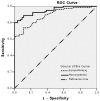Lipoprotein(a), homocysteine, and retinal arteriosclerosis
- PMID: 18806883
- PMCID: PMC2538495
Lipoprotein(a), homocysteine, and retinal arteriosclerosis
Abstract
Purpose: Elevated levels of lipoprotein(a) [Lp(a)] and homocysteine (Hcy) have been implicated as risk factors for vascular diseases. The study was performed to explore the possible relationship between retinal arteriosclerosis and serum Lp(a) and Hcy levels.
Methods: Study subjects consisted of 80 nonsmoking male patients with retinal arteriosclerosis and 54 healthy nonsmoker males as controls. Retinal arteriosclerosis was graded according to the Scheie classification. Serum levels of lipids, lipoproteins, Lp(a), and Hcy were measured by standard methods.
Results: The serum level of Hcy was higher in patients (24.2+/-8.1 micromol/l) than controls (10.5+/-4.1 micromol/l); p<0.01. Serum levels of Lp(a) in patients (47.9+/-33.1 mg/dl) was also higher than controls (11.7+/-7.6 mg/dl); p<0.01. There was a significant direct linear correlation between the degree of retinal arteriosclerosis and Lp(a) level (r=0.61, p<0.01), the degree of retinal arteriosclerosis and Hcy level (r=0.72, p<0.01), and also between Lp(a) and Hcy levels (r=0.67, p<0.01).
Conclusions: The association between retinal arteriosclerosis and serum Lp(a) and Hcy levels suggests that Lp(a) as well as Hcy could play a role in the development of retinal arteriosclerosis.
Figures




References
-
- Teikari JM, Laatikainen L, Rapola JM, Virtamo J, Haukka J, Liesto K, Taylor P, Heinonen OP. Retinal vascular changes following supplementation with alpha-tocopherol or beta-carotene. Acta Ophthalmol Scand. 1998;76:68–73. - PubMed
-
- Wong TY, Klein R, Klein BE, Tielsch JM, Hubbard L, Nieto FJ. Retinal microvascular abnormalities and their relationship with hypertension, cardiovascular disease, and mortality. Surv Ophthalmol. 2001;46:59–80. - PubMed
-
- Luo BP, Brown GC. Update on the ocular manifestations of systemic arterial hypertension. Curr Opin Ophthalmol. 2004;15:203–10. - PubMed
-
- Hu R, Zhang XX, Wang WQ, Lau CP, Tse HF. Smoking, homocysteine and degree of arteriolar retinopathy. Atherosclerosis. 2005;183:95–100. - PubMed
-
- Yung LM, Leung FP, Yao X, Chen ZY, Huang Y. Reactive oxygen species in vascular wall. Cardiovasc Hematol Disord Drug Targets. 2006;6:1–19. - PubMed
MeSH terms
Substances
LinkOut - more resources
Full Text Sources
Other Literature Sources
Medical
Miscellaneous
